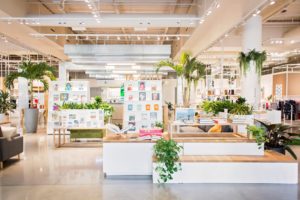
Date: 03-06-2020
Neighborhood Goods, which opened in Plano, TX, New York’s Chelsea Market, and Austin, TX in rapid succession – has been called “the department store of the future”. Melding a customer-centric ethos with media-style community-building, each store offers a neighborhood-appropriate F&B concept and a primarily DTC-mix of brands such as Rothy’s, hims & hers, Draper James (Reese Witherspoon), Serena (by Serena Williams), Entireworld and others, interspersed with products from more established brands such as Aēsop and Dollar Shave Club. The brand selection and story around each is curated carefully and adjusted for different, well, neighborhoods, and with this approach the Neighborhood Goods brand quickly came to represent a unique retail voice.
In March 2020, Neighborhood Goods was ranked by Fast Company as one of the World’s 50 Most Innovative Companies, and by that time had raised more than USD25M to expand its footprint. But we all know what happened later that month.
In this interview with Lyra Ventures’ Venture Partner, Debra Langley, CEO and co-founder, Matt Alexander, outlines what he’s been working on during the two-plus months since he made the decision to close all three stores simultaneously, how they’ve maintained their customer community, and what the Neighborhood Goods experience will feel like when their doors reopen.
UPDATE: As we post this interview, and in light of recent protest activity in US cities, uncertainty remains as to when Neighborhood Goods will reopen their stores. Irrespective of when this is, the Neighborhood Goods team will implement health and safety protocols, and are ready to close again if needed.
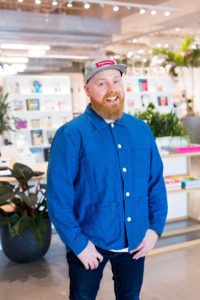 Debra Langley (“Debra”): You had opened Chelsea Market in November 2019, and Austin was planned for early March 2020, coinciding with the annual SXSW conference. Austin was open for 24 hours and then you made the decision to close all three stores. You were not only prescient but swift. How did you reach that decision, and how did you put together a plan when no one had any idea what lay ahead?
Debra Langley (“Debra”): You had opened Chelsea Market in November 2019, and Austin was planned for early March 2020, coinciding with the annual SXSW conference. Austin was open for 24 hours and then you made the decision to close all three stores. You were not only prescient but swift. How did you reach that decision, and how did you put together a plan when no one had any idea what lay ahead?
Matt Alexander (“Matt”): We had been tracking the proliferation of COVID-19 closely. I was sending regular communications to the team about cleanliness and best practices at the end of February. At the beginning of March, we started to develop contingency plans for a much more significant outbreak. Initially, we reduced our hours and implemented a stricter cleaning policy. Later, this included closing the stores. The decision was fairly straightforward. We opened our Austin location on Friday, March 13 in the evening with just about zero marketing. We cancelled events, emails, and the like. The message was essentially, “Hey! We’re open! But please don’t come!” Nonetheless, on Friday night and on Saturday morning we had a lot of traffic. We were continuing to see strong sales in Plano and New York as well.
It’s an odd problem to face as a retailer (i.e., good sales and traffic!), but it was clear that we had a civic obligation — both for our teams and our customers — to close. Ashley, our Chief of Staff, Patti, our SVP of Operations, and Lindsay, our Director of Store Operations, were in Austin with me and started to coordinate with the teams. I had a quick call with two board members to share the decision.
We received full backing from our investors and board members and around 3 or 4 p.m., we put out an announcement that we’d be closing. By coincidence, Warby Parker, Everlane, and Urban Outfitters, all made similar announcements around the same time, so we were in good company in that early wave. It was the right thing to do.
Debra: You’ve been closed now for 8 weeks – what did you put in place during that time, and how have your brand partners worked with you? We know that you’ve had great momentum online, and that curbside pickup and F&B take-out in Dallas have been popular. The situation has necessarily changed the relationship between online and offline; do you have a sense of whether that could become more permanent?
Matt: Immediately after closing the stores, we kicked off a few initiatives.
First, we launched Only Good Things on our social and editorial channels, a weekly collection of memes and positive content. It’s been running consistently since we closed and has been a great source of positivity.
Second, we re-focused on digital for the near-term. We told our brands that we would not be charging them during the closures and many of them repaid that gesture by opting-in to being featured on our website, if they hadn’t already. Our digital offering expanded while we worked to quickly improve the user experience. We introduced curbside pickup, on-demand delivery, and free shipping.
Third, we introduced The Commons. It’s an initiative to provide free space to brands, artists, and chefs when we reopen. They’ll have limited time with us, but if all goes to plan, it ought to help jumpstart business for them this summer.
Outside of those points, we’ve continued to iterate on policy and procedure, improve upon core operational competencies, and work to drastically improve some of our underlying systems for our offline and online efforts. By way of example, we’ve worked to make our website 3-5x faster, our curbside and BOPIS (“buy online, pick-up in store”) efforts to be more responsive, and our economic terms to be more favorable and efficient for our brands. These initiatives speak to both offline and online. I hate the term “omnichannel,” but that’s always been an aspect of our philosophy. I’ve always referred to it as allowing the customer to dictate their own terms as to how they want to shop and engage with us. In a post-COVID world, this will be more important than ever. All the efforts we’ve been making to improve digitally, allow for more convenience/choice for our customers.
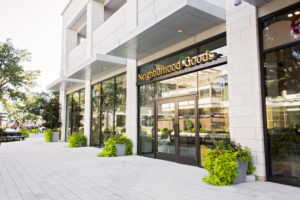
Debra: How have you stayed close to your customers and their changing sentiment? What are your customers telling you?
Matt: We’re seeing significant growth in our digital efforts, as well as great response to our F&B curbside experiments. Contrary to what we’ve been reading about the industry, we’re continuing to see a fairly good balance of success across retail categories. For example, apparel continues to perform very well for us.
I think customers invariably gravitate towards high-quality, thoughtful products and experiences, regardless of whether they’re digital or physical. That’s always been core to our philosophy. I think we’re seeing that manifest in our sales and engagement at the moment. Looking ahead, I think we can all expect shifts in consumer demand. But if you continue to offer a well-curated mix of relevant products, I think the consumer will still be there to shop with you.
Debra: While physical retail has been hit the hardest, we understand that brands of all kinds have been approaching you for post-COVID partnerships. In general, what kinds of brands are they and what has been the tenor of those conversations? They clearly still believe in the value of a store experience, but they must have a lot of questions about the “how” in the short term.
Matt: In addition to local and direct-to-consumer brands, we’re also hearing from well-established, traditional brands that’ve lost meaningful wholesale business during this time. With many traditional department stores struggling, this has created opportunity for us to work with a new group of brands.
For our traditional DTC customer, digital customer acquisition cost is affordable for the first time in years, as everyone has reduced (or cut off) their advertising budgets. Looking ahead, everyone is expecting, with more constrained budgets, a real fight for customers. Those costs will fly upward as budgets are loosened, but the fight will remain. Physical retail has been used as a fantastic and efficient solution to aid with these efforts in recent years, but, more than ever, brands are going to be wary of signing long-term leases or deploying lots of capital for pop-ups.
We’re hearing a lot of need for our platform from brands. We have a real role to play, as we’re able to help lower customer acquisition costs and create a valuable new sales channel. We may also have an increasing number of well-established brands needing our platform.
Debra: You recently launched The Commons, a new post-pandemic initiative to support creatives in music, art and food – tell us about that, and when you are planning to launch the program in store. How do you see it working in a new kind of retail environment, e.g. with social distancing guidelines in place and customers perhaps a bit wary of hanging out together in a crowd – especially in the smaller space in New York (or is it Plano only?)
Matt: We’re launching The Commons in all three stores, but it will be proportionate to the size of our stores. Our approach to curation, merchandising, and store design remains as important as ever, regardless of bringing in a slate of new brands to experiment.
In terms of the offering, it really breaks down as follows:
• For brands that are selected, they’ll be given free space in the store. We’ll take a modest percentage of sales. We’ll likely have 3-4 groups of brands per store, and will keep them there for one month at a time. The door will remain open for them to stay in-store for longer.
• For artists and musicians, we’ll allow them to display and/or perform in-store, as and when it’s safe.
• For restaurateurs, we’re largely focusing on those who haven’t been able to pay rent or may have temporarily lost their spaces. We’re going to let them take over our kitchen and bring in their core customers — pop-up versions of their restaurants, in a way — for them to help restart business and hopefully get their spaces back up and running a little bit more quickly. (Again, this will largely be free.)
Beyond that, we’re also intending to host job fairs for those who’ve become unemployed, as well as launching and facilitating all manner of private label efforts. Finally, I should add that when we reopen, regardless of The Commons, health and safety will be of the utmost importance. We’ll keep modified hours, we’ll be cleaning frequently, we’ll be maintaining limits on people in the store, and so on.
Debra: Revisiting the original thesis for Neighborhood Goods: your fundamental belief in brand storytelling, implementing those stories through different kinds of activations in-store, your curation of the brand and product mix based on the neighborhood in which each store is located. Has this period changed your thinking at all about what constitutes that unique NG experience?
Matt: Not at all! I think it’s more important and relevant than ever. If we offered the same mix of products in each store and did little to ensure that product mix is special, why would the customer visit our stores? That’s a question that was true pre-pandemic. It’ll be true post-, as well. Our stores have always been about discovery. Our digital has always been about utility.
I think that balance will remain, allowing us to provide a compelling place for people to visit, as well as something useful that enables them to order for same-day delivery, curbside pickup, or otherwise.
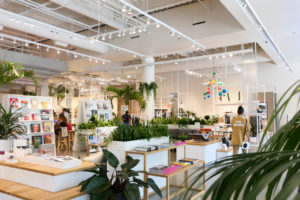
Debra: This is an extension to the question about how you’ll deploy The Commons, but how will the brand activations be modified in the near future? What about the technology and infrastructure to support this?
Matt: Our plans remain largely the same! We’ve always had an app, which allows customers to self-checkout and find products. And we’ve always had contactless payment, which’ll be helpful, too.
Beyond that, we have a lot of new initiatives in mind to further allow customers to dictate those terms and control their own experience. For our store employees, we’ll likely be allowing them to engage more digitally with our customers. And we’re working on more opportunities for personal shopping/styling, which can be a more controlled and personal experience than just browsing.
On the safety front, we’re developing the means to show traffic lights, of sorts, to show when the store is too busy. It’ll help people better plan visits.
Debra: One of the key USPs of Neighborhood Goods is your engaged and informative retail associates, and how they interact closely with customers. How will you adapt to a new normal (again, with social distancing, ongoing need to sanitize items after they’ve been touched/tried on, etc) to collect the customer feedback that sales associates are able to capture for brands?
Matt: The store staff will remain as engaged as ever. In addition to the core principles of the experience — and the items in the prior question — we’ve been exploring live chat with our store staff for quite some time. I think that’s something we’ll be looking to fast track. So, whether you’re at home or in the store (but wary of walking around with staff), we’ll want to ensure you have access to our thoughtful storytellers.
Outside of that, we’ll of course be engaging in significant cleaning efforts, limiting traffic, avoiding try-ons, and otherwise ensuring the experience remains sound.
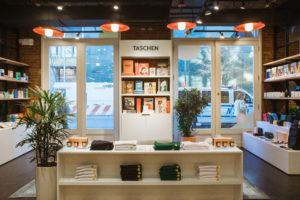
Debra: Are you rethinking your expansion strategy in the next 12-18 months, e.g. in terms of which cities or countries and when?
Matt: We’re continuing to plan expansion efforts, but we’re certainly looking at it more opportunistically than originally planned. Given all that’s happening in the retail and real estate industries, we’re starting to see a lot of unique options — domestically and abroad — that are worth exploring.
Debra: From great adversity comes great opportunity – what are some of the opportunities you’re seeing now that may not have existed three months ago, or that you may not have considered at that time?
Matt: To name two right off the bat: we’re hearing from more brands than ever, while we’re also seeing more opportunity in real estate than ever. As a bonus third, we’ve always been wanting to build more of a digital business. Now, with all the systems we’ve overhauled, that’s become a reality much faster than we would’ve anticipated. We see an opportunity to expand, work with more brands, and develop more of a true “omnichannel” experience than we’d previously contemplated.
Debra: And finally, can you share with us one new thing you learned about yourself during the period you were locked down?
Matt: Mental space is important. For the months leading up to the lockdown, I’d been traveling at least once a week and working near-constantly. Being able to settle into more of a routine has allowed me to see more areas for improvement in both myself and the company. I’ve been able to slow down and see things more clearly. And that’s something I’ll want to maintain, even when we get back to (some degree of) normal.
<< Back to News

